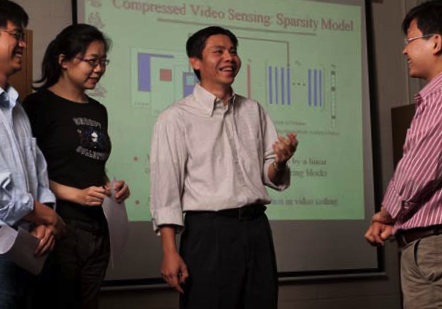 The golden grail of image processing is getting the most amount of information in the least amount of “space.” That means you try to cram as many visual details into the smallest amount of 0s and 1s as possible. Given a fixed bit budget (file size), the more faithful the details, the better the picture.
The golden grail of image processing is getting the most amount of information in the least amount of “space.” That means you try to cram as many visual details into the smallest amount of 0s and 1s as possible. Given a fixed bit budget (file size), the more faithful the details, the better the picture.
The Hopkins Digital Signal Processing Laboratory, headed by Trac D. Tran, associate professor in the Department of Electrical and Computer Engineering, has developed algorithms that can greatly improve both still pictures, such as the familiar JPEG format on web pages, and digital video, like the MPEG format on DVD. Tran and his group specialize in transformation—a mathematical mapping that converts raw image/video pixels into a much terser, sparser representation, leading to improved compression efficiency. You probably carry one of Tran’s algorithms in either your cell phone or your Blu-ray Disc player.
Tran and colleagues have also produced a family of transformation for video, one that is currently represented in most smart phones. Tran’s transform algorithms allow the video data to be processed within a 16-bit architecture, which while fairly crude for a contemporary computer is perfect for small, hand-held devices like Apple iPhones and iPods. Those gadgets require something that will not suck up battery power and are small enough to fit in the hand. “My group pioneered this line of research 10 years ago,” says Tran.
Now he and his team are poised to see their newest technological wizardry unveiled—in an application expected to take the consumer world by storm.
The current international standard for still images is JPEG, which is the default image format in most digital cameras. The problem with JPEG lies in its 20-year-old technology. A new image compression algorithm and file format developed by Microsoft, called HD Photo, is expected to become the next international image standard later this year under the name JPEG XR (XR stands for extended range, stressing its ability to handle high-quality, highdynamic- range images). The technology already is available in Windows Vista and the upcoming Windows 7. JPEG-XR delivers a compressed image of better perceptive quality than JPEG at less than half the file size. It is, Tran says, as hardware-friendly as JPEG and likely to wind up in a camera near you.
At the heart of JPEG XR is a fast lossless-based on the concept of what he calls “pre-filtering” and “post-filtering,” which improves compression efficiency while retaining most practical features of the original JPEG.
“One advantage that the JPEG XR transform offers is the lossless coding capability, so you don’t lose anything if you don’t want to,” Tran says. “When people buy high-end cameras, they want to capture images as they are, without compression.” They like their images “raw.” Thus, camera manufacturers strive for any compression scheme that can be efficiently implemented without losing any information. Tran’s memory buffering transform allows raw shooting with faster frame speed—from the current three frames per second to possibly eight to 10.
“It’s a pretty big deal,” says Tran. “Not too many scientists have their algorithm adopted by the industry, let alone become a part of an international standard that can potentially alter the consumer electronics landscape.”




